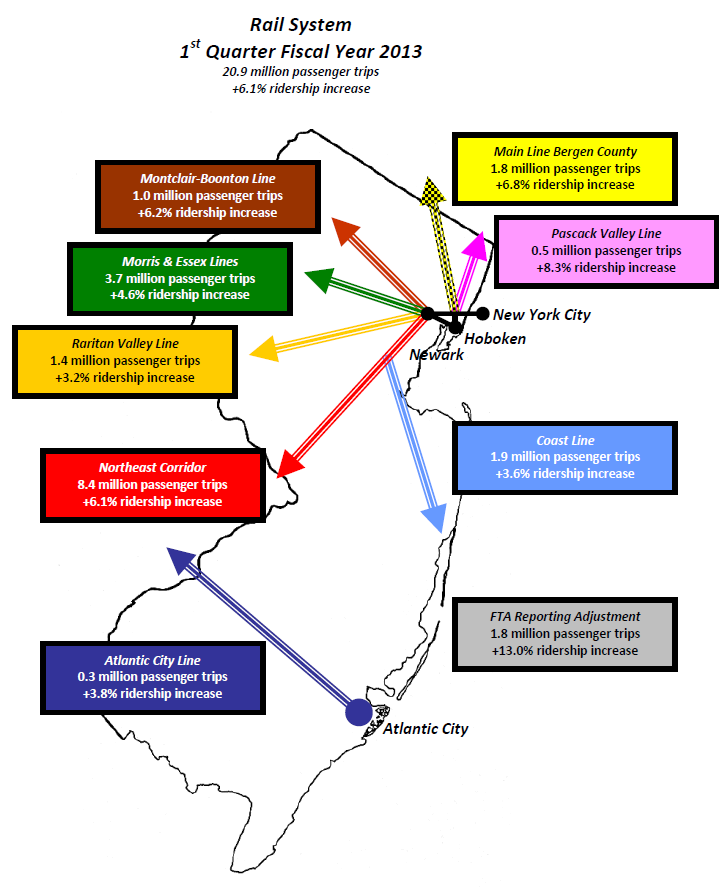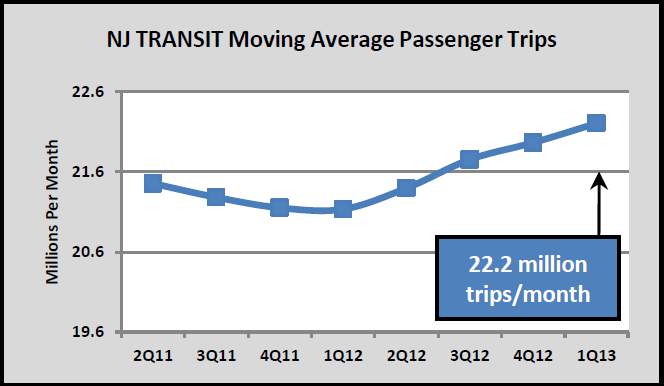
With Governor Christie set to announce the 2014 budget sometime in late February, recently released data from NJ Transit makes a compelling case for increasing funding for transit operations in the state.
The latest analysis of ridership trends found that during the first quarter of Fiscal Year 2013 (July-September 2012), system wide, NJT averaged 22.2 million monthly passenger trips, a two year high. This represents a 4.5 percent increase over the same time period in Fiscal Year 2012. Average weekday and weekend passenger trips were both at their second-highest first quarter levels ever. Weekend passenger trips saw the most substantial increase when compared to the same period last year with Sundays having the biggest increase at 14.7 percent (9.9 percent increase on Saturdays). Ridership now exceeds levels attained prior to the May 2010 fare change, and is only about 3 percent below its pre-recession all-time high. NJT attributes the latest ridership bump to employment gains, Port Authority toll hikes which have shifted transportation modes, improved weather conditions, marketing campaigns, and higher gas prices.
Ridership gains were made across transit modes:
Rail
• Average monthly rail passenger trips were at 6.2 million, the highest in two years. Rail also saw its largest quarterly growth in two years (6.1 percent).
• Saturday passenger trips saw the most substantial increase of 13.6 percent when compared to the same period last year.
• Passenger trips to and from New York Penn Station grew by 7.8 percent.
Bus
• Bus ridership increased 4 percent during the first quarter of FY2013 compared with the same period the previous year.
• Sunday passenger trips saw the most substantial increase of 16.3 percent when compared to the same period last year.
The ongoing challenge for NJ Transit is how to address increased transit demand within funding constraints. NJT’s operating expenses outpace operating revenues forcing the agency to transfer dollars from its capital budget to meet its operating needs. This is an unsustainable funding scheme that makes it difficult for NJ Transit to plan for the years of growth ahead. Legislators must find new funding solutions to help ensure NJ Transit can keep pace with the rising demand.



[…] Pre-Sandy, NJ Transit Ridership Close to Pre-Recession High; Weekends Show Biggest Gains (MTR) […]
[…] transportation infrastructure (i.e. return to the fix-it-first policy, especially post-Sandy), increased transit service and provided greater cross-Hudson access. With all this borrowing for Turnpike Authority (and […]
I come from NY and I understand NJ Transit position of not having trains running at certain times when the ridership is low or non existent. But, there are many cases when the ridership is overwhelming and becomes uncomfortable. Yet, they do not make adjustments. I’m talking about buses and trains. Yet, the cost of NJ Transit doesn’t seem anywhere near fair…Like the PA with all those fair hikes and NY Transit also. Where is this money going?
[…] New Jersey Transit Ridership Trends Illustrate the Need for More Transit Funding Ridership is steadily increasing, but the Garden State’s lack of support to shore up the Transportation Trust Fund makes it difficult for NJ Transit to plan for years of growth ahead. […]